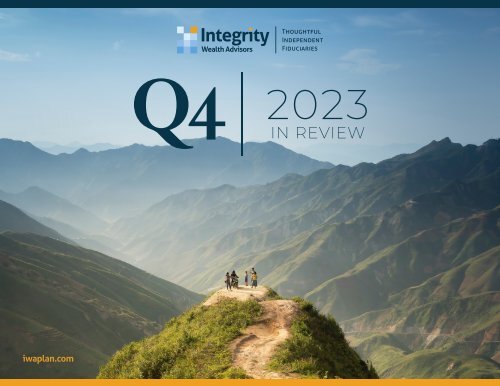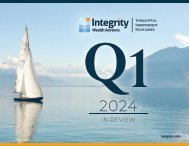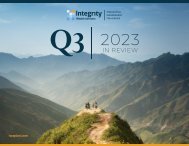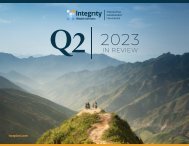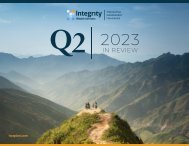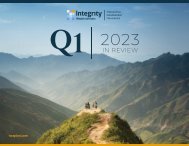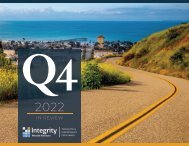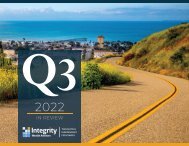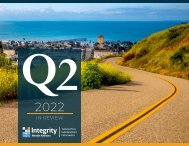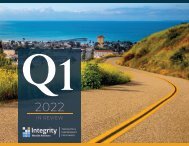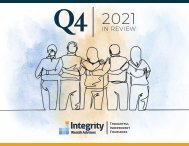2023 Q4 In Review - Integrity Wealth Advisors, Ventura & Ojai, California
- No tags were found...
You also want an ePaper? Increase the reach of your titles
YUMPU automatically turns print PDFs into web optimized ePapers that Google loves.
iwaplan.com<br />
<strong>Q4</strong> <strong>2023</strong><br />
IN REVIEW
TOTAL RETURN <strong>2023</strong> <strong>Q4</strong> + NEWSWORTHY EVENTS<br />
October 5 – The<br />
decision by OPEC to<br />
keep production at its<br />
current pace pushes<br />
prices lower, with WTI<br />
contracts at less than<br />
$84 a barrel<br />
October 17 – Stock Markets fall<br />
as economic data suggests that<br />
the U.S. Consumer is faring well,<br />
and inflationary pressures will<br />
remain sticky<br />
October 31 – The<br />
UAW strike ends after<br />
46 days<br />
November 14 – The Consumer<br />
Price <strong>In</strong>dex shows prices rising<br />
at a lower than expected 3.2%<br />
year over year<br />
December 13 – The<br />
Federal Reserve strikes a<br />
more dovish tone, again<br />
deciding to hold interest<br />
rates unchanged<br />
October 7 – Hamas<br />
launches an invasion<br />
into southern Israel<br />
from the Gaza Strip<br />
October 25 – Mike Johnson<br />
elected House speaker with<br />
unanimous GOP support,<br />
ending weeks of chaos<br />
November 1–Federal<br />
Reserve policymakers<br />
decided to leave interest<br />
rates unchanged and to<br />
keep rates higher for longer<br />
December 6 – ADP Payrolls<br />
report shows jobs increased<br />
by 103,000, lower than<br />
expected<br />
December 28 – Eight<br />
people hospitalized<br />
after massive wave<br />
knocks over beach<br />
goers in <strong>Ventura</strong>, CA<br />
12%<br />
S&P 500 TOTAL RETURN<br />
MSCI ACWI EX USA TOTAL RETURN<br />
BARCLAYS US AGGREGATE TOTAL RETURN<br />
11.69%<br />
10%<br />
9.82%<br />
8%<br />
6%<br />
4%<br />
2%<br />
2.38%<br />
0%<br />
-2%<br />
-4%<br />
October<br />
November<br />
December<br />
As of close 12/29/<strong>2023</strong><br />
12%<br />
S&P 500 TOTAL RETURN<br />
MSCI ACWI EX USA TOTAL RETURN<br />
BARCLAYS US AGGREGATE TOTAL RETURN<br />
Source: https://en.wikipedia.org/wiki/<strong>2023</strong><br />
11%<br />
10.42%
THE WHIPLASH OF <strong>2023</strong> IS BEHIND US<br />
<strong>2023</strong><br />
<strong>Q4</strong><br />
IN REVIEW<br />
<strong>In</strong>vestors will likely remember <strong>2023</strong> for its many ups and downs, encompassing war,<br />
strikes, natural disasters, leadership changes, and alternating double-digit total market<br />
return declines and surges. This roller-coaster journey mirrored investors' evolving<br />
perspectives on Federal Reserve policies, inflation, and the state of the US economy.<br />
<strong>In</strong>vestors also responded to a variety of events, including the failures of Silicon Valley<br />
Bank and Signature Bank in the US and Credit Suisse overseas, an auto workers strike,<br />
and heated debt ceiling negotiations within a divided US Congress. Emerging secular<br />
themes—most notably advances in artificial intelligence and weight loss drugs—<br />
disrupted the markets as investors discerned which companies and industries were<br />
poised for success or setback.<br />
As fall approached, a sense of gloom enveloped the market as investors grappled<br />
with the prospect of enduring higher-for-longer interest rates and persistent inflation,<br />
despite some declines. Although the Federal Reserve halted its rate tightening in<br />
September, hopes for imminent rate cuts were dashed as the central bank reiterated<br />
its guidance that rates would remain elevated for an extended period. The US 10-Year<br />
Treasury Bond yield reached multi-decade highs, and the Israel-Hamas war further<br />
heightened geopolitical uncertainty.<br />
However, the tide shifted dramatically in the final months of the year. Towards<br />
late October, moderating economic and inflation data, coupled with the Fed's<br />
continued pause, propelled stocks on an upward trajectory. Market optimism surged<br />
even more in December when the Fed suggested multiple rate cuts in 2024 would not<br />
be unreasonable—a stark departure from its previous stance.<br />
Following the fourth quarter rally, many investors may be wondering if the robust<br />
market gains can last, particularly given the uncertainties on the horizon. The Fed will<br />
continue to be a focal point for investors. However, we feel it will be in a positive way,<br />
as opposed to last year.<br />
Although we expect the economy to slow in 2024, a substantial amount of data points<br />
towards a soft landing for the US economy. Corporate earnings should rebound this<br />
year, which is the backbone for stock market valuations. Additionally, we anticipate<br />
a return to more typical market volatility, with less of the extreme fluctuations with<br />
which we have become familiar over the past four years. As always, it is not wise<br />
to try to time the market, and letting your financial planning goals steer your asset<br />
allocation is of paramount importance.<br />
ECONOMIC CHARTS & NOTES<br />
CONSUMER SENTIMENT Consumer sentiment reached the highest level since<br />
July due to a sharply lower inflation outlook. As inflation eased, retail sales gained<br />
momentum into the holiday shopping season.<br />
EMPLOYMENT Unemployment slipped to 3.7% in November as labor force<br />
participation improved. The jobs market rebounded due to government hiring and<br />
the end of auto and entertainment industry strikes.<br />
US Retail Sales<br />
Consumer Sentiment<br />
Unemployment Rate<br />
NonFarm Payroll<br />
34%<br />
100<br />
16%<br />
2200<br />
US Retail Sales % Chg<br />
28%<br />
22%<br />
16%<br />
10%<br />
4%<br />
-2%<br />
-8%<br />
90<br />
80<br />
70<br />
60<br />
Consumer Sentiment<br />
Unemployment Rate %<br />
14%<br />
12%<br />
10%<br />
8%<br />
6%<br />
4%<br />
-825<br />
-3850<br />
-6875<br />
-9900<br />
-12925<br />
-15950<br />
-18975<br />
NonFarm Payroll<br />
-14%<br />
Jan '19<br />
Jul '19<br />
Jan '20<br />
Jul '20<br />
Jan '21<br />
Jul '21<br />
Jan '22<br />
Jul '22<br />
Jan '23<br />
Jul '23<br />
50<br />
2%<br />
Jan ' 19<br />
Jul '19<br />
Jan '20<br />
Jul '20<br />
Jan '21<br />
Jul '21<br />
Jan '22<br />
Jul '22<br />
Jan '23<br />
Jul ' 23<br />
-22000<br />
Source: University of Michigan Consumer Sentiment. Retail Sales - U.S. Census Bureau.<br />
Source: U.S. Bureau of Labor Statistics
ECONOMIC CHARTS & NOTES<br />
CONSUMER PRICE INDEX <strong>In</strong>flation cooled to 3.1% from 7.1% a year prior.<br />
Consumers got relief from lower gasoline prices and a more modest uptick in<br />
food prices.<br />
CONSUMER SPENDING <strong>In</strong>flation-adjusted disposable income and spending<br />
both increased as compensation rose and Americans spent more on travel,<br />
housing, and food.<br />
Y/Y % Chg<br />
8%<br />
7%<br />
6%<br />
5%<br />
4%<br />
3%<br />
2%<br />
1%<br />
0%<br />
CPI Less Food<br />
2018 2019 2020 2021<br />
CPI All<br />
2022 <strong>2023</strong><br />
% Chg Year-over-year<br />
35<br />
30<br />
25<br />
20<br />
15<br />
10<br />
5<br />
0<br />
-5<br />
-10<br />
-15<br />
-20<br />
-25<br />
Jan '19<br />
Consumption<br />
Disposable <strong>In</strong>come<br />
Jul '19 Jan '20 Jul ' 20 Jan '21 Jul '21 Jan '22 Jul '22 Jan '23 Jul '23<br />
Source: U.S. Bureau of Labor Statistics<br />
Source: U.S. Bureau of Economic Analysis<br />
JOB OPENINGS & HIRES Retail hiring and job postings were below<br />
2022 levels as stores took a cautious stance around challenging economic<br />
conditions.<br />
GDP The domestic economy grew at its fastest pace in 2 years in Q3. Slower<br />
growth is expected for <strong>Q4</strong> and 2024 but potential interest rate cuts could provide<br />
a boost.<br />
Retail Openings<br />
Retail Hires<br />
GDP<br />
Amount in Thousands<br />
1500<br />
1200<br />
900<br />
600<br />
300<br />
0<br />
Jan '18 Jul '18 Jan '19 Jul '19 Jan '20 Jul '20 Jan '21 Jul '21 Jan '22 Jul '22 Jan '23 Jul '23<br />
% Growth<br />
35%<br />
30%<br />
25%<br />
20%<br />
15%<br />
10%<br />
5%<br />
0%<br />
-5%<br />
-10%<br />
-15%<br />
-20%<br />
-25%<br />
-30%<br />
Q1 Q2 Q3 <strong>Q4</strong> Q1 Q2 Q3 <strong>Q4</strong> Q1 Q2 Q3 <strong>Q4</strong> Q1 Q2 Q3 Q1 <strong>Q4</strong> Q2 Q3 <strong>Q4</strong> Q1 Q2 Q3<br />
2018<br />
2019 2020 2021 2022 <strong>2023</strong><br />
Source: U.S. Bureau of Labor Statistics<br />
Source: U.S. Bureau of Economic Analysis
THE END OF HISTORIC FED HIKES<br />
USHERS IN OPTIMISM<br />
<strong>2023</strong><br />
<strong>Q4</strong><br />
IN REVIEW<br />
As inflation recedes alongside a moderating<br />
economy, bond investors are experiencing a<br />
sense of relief, speculating that the Federal<br />
Reserve may have concluded its interest<br />
rate hikes. With yields in bond markets<br />
approaching levels not seen in two decades,<br />
there is anticipation that bonds could stage a<br />
remarkable comeback in 2024.<br />
<strong>In</strong>vestors have encountered similar situations<br />
in the past, only to witness the central bank<br />
persistently raise rates as inflation fails to<br />
decelerate rapidly enough. The distinguishing<br />
factor this time is the convergence of inflation<br />
nearing its target and a wealth of data<br />
highlighting the adverse impact of elevated<br />
interest rates on the economy.<br />
Having maintained rates at its current range<br />
of 5.25% to 5.50% for several months, the Fed<br />
has signaled a shift in its stance after initiating<br />
rate hikes in March 2022. Officials are now<br />
projecting three rate cuts, aiming to reduce<br />
borrowing costs to 4.6% by the conclusion of<br />
2024.<br />
Meanwhile, employment and consumer spending have displayed unexpected<br />
resilience. The unemployment rate held steady at 3.7% in November, with 199,000<br />
jobs added. That rate is above the 50-year low of 3.4% that the U.S. hit in April <strong>2023</strong>.<br />
The point in the cycle when the Fed is done hiking rates has tended to be an<br />
attractive time to own duration, which measures a bond’s sensitivity to interest<br />
rates and is a characteristic of bonds with longer maturities. History tells us that<br />
the end of rate hiking cycles in the U.S. have been followed by periods of significant<br />
outperformance in fixed income.<br />
AGGREGATE BOND MARKET RETURNS AFTER FED HIKES<br />
End of Fed<br />
Hiking Cycle<br />
Fed Rate<br />
1 year after<br />
2 years after<br />
(annualized)<br />
3 years after<br />
(annualized)<br />
Aug 1984 11.75 27.41 24.65 18.94<br />
Feb 1989 9.75 11.97 11.65 12.66<br />
Feb 1995 6.00 14.32 9.93 10.25<br />
May 2000 6.50 14.29 10.86 12.62<br />
July 2006 5.25 5.41 3.66 5.45<br />
Dec 2018 2.50 14.54 12.19 7.59<br />
SOURCES: ycharts.com, data from Jan 5, 2024
ÿÿÿÿ ÿÿ )*ÿ4!&!4'%45,.6!%2ÿ(")07(ÿ#.&'ÿ .*4ÿ9-1"!54'0.4'ÿ1)+(ÿ0)9,.*'4ÿ ,"ÿ-,ÿ!%ÿ"#'ÿ.*"!/!0!.1ÿ!%"'1!2'%0'ÿ ~€‚ƒ„…†ÿˆ„‰ÿŠƒ‹ŠÿŒƒƒŒŽ…ŒÿŽ‰†ÿ‰Žÿˆ‰ÿ‘Ž€„’ÿ‚ŠŽÿ“‰”Ž‚ÿŽ‰‹Ž<br />
BRIGHT PROSPECTS FOR QUALITY DIVIDEND PAYERS<br />
(ÿ/)*ÿ!%&'(")*(; 7'"; %"!.1ÿ/)*ÿ*'0'((!)%ÿ1!%2'*!%23ÿ +"#ÿ'
ABCDÿFGHBÿIJCÿKLHMÿNJOBPQRJSÿ QTULHSTÿBGBVQRLJÿHJVBUQIRJQK wxyz{|}~ÿ~}|~y‚ÿƒ„…}ÿ†}}yÿ‚‡‡ˆ„~ÿ‰ƒ}|ƒ}~ÿ„ÿŠ}x‹~„|ÿx~ÿŒ}†ˆ‡‹„yÿ‰xy<br />
<strong>2023</strong><br />
<strong>Q4</strong><br />
IN REVIEW<br />
INVESTING THROUGH ELECTION UNCERTAINTY<br />
LONG-TERM RETURNS HAVE BEEN SIMILAR WHETHER A DEMOCRAT OR REPUBLICAN WON<br />
10-year growth of hypothetical $10k investment made in the S&P 500 <strong>In</strong>dex at start of election year (USD)<br />
7 67 7 87 7 7 Ž‘’“”ÿ–”—˜šÿ—›ÿš‘œ—š’ž“Ÿÿ ##$%&'(ÿ)$# **+,-ÿ ÿ<br />
/0123456*7+8-<br />
!"ÿ @ Ž¡ÿ¢£’¤¥’¢ÿ¥“¦’ÿ¢ÿš’ÿ§¨©ÿªÿ«¢¦’¬ÿ“ÿ¤“”ÿ—›ÿ’Ÿ’ž—¢ÿ‘’“”ÿ®§¯°<br />
90:;35?<br />
±>6dÿ6d0ÿ²bWbÿ:40X>^0?6>5=ÿ0=036>2?ÿ=0XXÿ6d5?ÿ5ÿh054ÿ5l5h]ÿ<br />
7<br />
>?t0X624Xÿ540ÿk00=>?iÿ5?o>2;Xÿ5=ÿ40536b >?3=;^>?iÿ>?604?56>2?5=ÿ:2=>3h]ÿ6d0ÿ>1:536ÿ2kÿ>?k=56>2?ÿ5?^ÿ ?;1042;Xÿ>1:2465?6ÿX23>5=ÿ>XX;0X]µÿX5hXÿ:2=>6>35=ÿ032?21>X6ÿ 56ÿ>=04bÿ´·;6ÿ5ÿ=26ÿ35?ÿ3d5?i0ÿ=ÿ30465>?=hÿ?^ÿk24ÿt2604X]ÿ i2>?iÿ62ÿd;46ÿ5ÿX03624]ÿ6d56ÿ32?304?ÿ>Xÿ;X;5=hÿ2t04Xÿl24>0^ÿ6d56ÿ5ÿ?0lÿi2t04?10?6ÿ:2=>3hÿ>Xÿ 2::246;?>6>0Xbÿ 6d0ÿ5^^0^ÿ;?30465>?6hÿ35?ÿ:42t>^0ÿ564536>t0ÿ>?t0X610?6ÿ 6d42;idÿ15?hÿ0=036>2?ÿ3h3=0Xÿ>?ÿd>Xÿm»gh054ÿ354004]ÿ0t0Xÿ c¹;>6hÿ:246k2=>2ÿ15?5i04ÿ92?t0X60^ÿ ±d>=0ÿ154³06Xÿ35?ÿ=0ÿ>?ÿ0=036>2?ÿh054X]ÿld>3dÿ:2=>6>35=ÿ<br />
º2t0=530ÿX5hXbÿ´¼>idg¹;5=>6hÿ321:5?>0Xÿ2k60?ÿi06ÿ35;id6ÿ>?ÿ :546hÿ65³0Xÿ6d0ÿ±d>60ÿ¼2;X0ÿd5Xÿd5^ÿ=>6=0ÿ>1:536ÿk24ÿ=2?ig6041ÿ<br />
:2=>6>35=ÿ342XXd5>4X]ÿld>3dÿ35?ÿ340560ÿ5ÿ?iÿ2::246;?>6hbÿ >?t0X624XbÿW>?30ÿeqmr]ÿ6d0ÿefgh054ÿ5??;5=>¿0^ÿ406;4?ÿ2kÿ²bWbÿ<br />
As we enter into a U.S. presidential election year, there is a sense of unease among<br />
investors regarding potential market reactions. We believe that several pivotal issues will<br />
W2;430XYÿ[5:>65=ÿ\42;:]ÿW65?^54^ÿ_ÿ`224aXbÿc53dÿefgh054ÿ:04>2^ÿ?Xÿ2?ÿj5?;54hÿeÿ2kÿ6d0ÿk>4X6ÿh054ÿXd2l?ÿ5?^ÿ0?^Xÿ2?ÿ/03014X6ÿ:04>2^ÿ=>X60^ÿpeqmrsÿ ·;6ÿ½ÿ6h:>35=hÿ64hÿ62ÿ=22³ÿ2?ÿ3h3=0ÿ5?^ÿ5>1ÿ X623³Xÿp5Xÿ105X;40^ÿ
IAÿEJOAPKQÿLKÿRSRT @AABÿDAEÿFAEGAEHIJÿJHEKLKMNÿ ‹ŒŽÿ‘’“”Ž”•–ÿ•“Œ—˜ÿ‘š›‘œ˜‘ÿ’œ“Œ––ÿ’žŒ“ÿ’“Ÿ‘˜– ¡¢£¤¥¢¦§ÿ¥©©ª¥«ÿ¦¥¬©£©¡ÿ¬®¯¢° ±²˜ÿ‘œŒ”ŒŽœÿŽ”Žœ’˜Œ“–ÿŒ³‘“ÿ’ÿŽš‘ÿŒ²˜ŒŒŸ<br />
LOOK OUT FOR A CORPORATE EARNINGS REBOUND<br />
ìíöïëëí÷ï òæòó ÉÊËÌÍÎÿÅÌÏÌÍÐ òæòô ´°¦ÿµ®©¦¬¦©·¦ÿ¸®¥¬§ÿ¹¦¥§£©ÿ ·®©®¤£·ÿº©§¦»¼ÿ<br />
ëíðïõíëï òæòóòæòô ËÊÌÍÖÊÏÌËÔÊÏÓ ÑÍÒÍÓÔÕÍÎÿ Ä×ÍÖØËÊØÿ×ÏÖÙÍÌÐ òæòóòæòô pV[g`g~Z ÚÍÛÿÜÊÍ×ÕÓÔÝ×ÍÊÌÿÞÓÏË×Ð „ZW`Xb^ „Zub`g~Z<br />
áÞÔÊÐÜ×ÍÖÿØÔÔÎÐâ éÔÜÖÐÿÛÔÖÙÍÎ<br />
¾ÒÍÖÏØÍÿ×ÏÊÜßÏÞÌÜÖËÊØ ÚÍÛÿÖÍÐËÎÍÊÌËÏÓÿãÜËÓÎËÊØÿÕÍÖ×ËÌÐ ÅäÃÿåææÿÇÊÎÍç<br />
ÿÿÿÿÿÿÿÿ êëìíîï ëðíñï<br />
SOLID EARNINGS GROWTH EXPECTED ACROSS MAJOR MARKETS BUT ECONOMIC INDICATORS OFFER A MIXED OUTLOOK<br />
Estimated annual earnings growth<br />
The Conference Board Leading Economic <strong>In</strong>dex ®<br />
ÿÿ ÿÿÿÿÿÿÿ%ÿ! ÿÿ'!(!&ÿ)ÿ(ÿ %ÿÿÿ(*+ÿ,--ÿÿÿÿÿÿ../ÿ ÿ0-01&ÿÿÿÿÿ%ÿ !ÿ"ÿ#ÿÿÿÿ$ÿ%&ÿÿ ÿ%ÿÿÿ ÿ2(!ÿ 7ÿÿ0-08ÿ#ÿÿÿ &ÿ4ÿÿÿ%ÿ<br />
áÕÖÔÎÜÞÍÖÐâ<br />
34ÿÿ#ÿÿ%ÿ5!./ÿÿÿÿ ÿ$ÿÿÿÿ.6/ÿÿÿ ÿ$! '$ÿÿ! ÿ:&ÿÿÿ%ÿ$ÿÿÿ#ÿÿ %ÿ&ÿ#ÿÿ#ÿÿ9%ÿ ÿÿÿ%ÿÿÿÿÿ $ÿÿÿÿÿÿÿ&ÿ # ÿÿÿÿ0-01&ÿ#ÿÿ%ÿÿ ÿÿ$ÿÿÿ!ÿ"ÿÿÿÿ
A VALUATION DISCOUNT NOT SEEN IN TWO DECADES<br />
<strong>2023</strong><br />
<strong>Q4</strong><br />
IN REVIEW<br />
The Russell 2000 is currently traded at approximately a 55% discount compared to<br />
the Russell 1000, deviating significantly from its 10-year average discount of 32%.<br />
This valuation gap is among the widest in the past two decades. The S&P 600 index<br />
has a forward price-to-earnings ratio of only 13.6 times, which is lower than its 10-<br />
year average of 17.1 times, representing a 30% discount to the S&P 500. Whether<br />
examining price-to-earnings or price-to-book, the relative valuations remain 10%<br />
to 15% lower than the levels observed just before the regional banking crisis. This<br />
suggests a potentially robust upside for small-cap companies in the coming months.<br />
Despite the limitations of valuation as a timing tool, other favorable factors exist<br />
for the small-cap stock space. The Federal Reserve's anticipation of rate cuts this<br />
year is advantageous for small businesses, given that nearly half of the debt held by<br />
Russell 2000 companies is at a floating rate, compared to around a tenth for largecap<br />
companies. Consequently, Fed rate cuts could swiftly reduce interest expenses<br />
for small-cap companies. Similar to large-caps, earnings growth for small-caps is<br />
expected to pick up in 2024. Although there is no official forecast for small-cap<br />
earnings growth, small-caps' performance is highly correlated with large-caps, albeit<br />
with more significant fluctuations in both positive and negative directions.<br />
Historically, small-cap stocks have demonstrated a tendency to outperform larger<br />
companies over the long term, and the current relative valuation further enhances<br />
the attractiveness of allocating resources to this segment.<br />
RELATIVE VALUATIONS: SMALL-CAPS VS. LARGE-CAPS<br />
1.4<br />
1.2<br />
1.0<br />
RELATIVE P/E RATIO<br />
0.8<br />
0.6<br />
0.4<br />
2000<br />
2001<br />
2002<br />
2003<br />
2004<br />
2005<br />
2006<br />
2007<br />
2008<br />
2009<br />
2010<br />
2011<br />
2012<br />
2013<br />
2014<br />
2015<br />
2016<br />
2017<br />
2018<br />
2019<br />
2020<br />
2021<br />
2022<br />
<strong>2023</strong><br />
Ratio of Russell 2000 P/E Relative to Russel 1000 P/E<br />
Historical Average<br />
SOURCE: FactSet from December 31, 1999 to September 30, <strong>2023</strong>. For both indexes, the P/E is the weighted-overage P/E multiple, based on fiscal-year forward earnings, of all companies with positive earnings within the<br />
respective index.
INVESTMENT<br />
MANAGEMENT<br />
PHILOSOPHY<br />
The complex, ever-changing investment world of today<br />
requires an investment process that is overseen by a team<br />
of experienced investment professionals. Global capital<br />
markets present investors with a host of challenges due to<br />
the combination of an overwhelming amount of information<br />
to analyze and the endless supply of conflicting opinions and<br />
narratives surrounding financial markets. The time and expertise<br />
required to perform in-depth investment research and to make<br />
timely and informed portfolio management decisions requires<br />
both a clear investment process and an experienced investment<br />
team to implement the process.<br />
An old adage states that there is accomplishment through<br />
many advisors. We agree and embrace a variety of investment<br />
perspectives through our investment committee. Our investment<br />
philosophy is well grounded in global macro-economic analysis.<br />
<strong>In</strong>vestment ideas are carefully vetted through a process which<br />
incorporates the diverse range of investment backgrounds<br />
within our firm. This process of multifaceted analysis ensures<br />
that only the strongest investment ideas survive. We are<br />
committed to striking the right balance between risk and<br />
return through managing global, multi-asset class investment<br />
portfolios.<br />
INDEPENDENCE &<br />
CLIENT FOCUS<br />
DIVERSIFICATION<br />
TOP-DOWN, THEMATIC<br />
APPROACH<br />
PERFORMANCE WITH<br />
LIQUIDITY<br />
VARIED INVESTMENT<br />
PERSPECTIVES<br />
OPTIMIZATION OF<br />
EXPENSES AND TAXES<br />
THE INVESTMENT PROCESS<br />
ASSESSMENT OF GLOBAL<br />
ECONOMIC & INVESTMENT<br />
ENVIRONMENT<br />
ASSESS & ANALYZE<br />
THEMES<br />
RESEARCH INVESTMENT<br />
VEHICLES TO FIND<br />
EFFECTIVE IMPLEMENTATION<br />
IDENTIFY<br />
OPPORTUNITIES<br />
STRATEGIC ASSET<br />
ALLOCATION -<br />
Geographies, Sectors,<br />
Capitalizations<br />
INVESTMENT SELECTION -<br />
Open/Closed End Funds, ETFs, Stocks & Bonds
INVESTMENT COMMITTEE<br />
<strong>2023</strong><br />
<strong>Q4</strong><br />
IN REVIEW<br />
The <strong>In</strong>vestment Committee meets formally each quarter,<br />
and more frequently if market conditions warrant, to discuss<br />
the state of the global economy and capital markets and<br />
to assess the current asset allocation and positioning of<br />
our portfolios. There’s an art to striking the right balance<br />
between risk and return; pursuing that symmetry is the core<br />
of our investment philosophy. We are fiduciaries and have<br />
our interests aligned with our advisory clients, as we invest<br />
alongside them. Contact us at investmentcommittee@<br />
iwaplan.com with any questions or concerns.<br />
STEPHEN WAGNER<br />
CEO, <strong>In</strong>vestment Advisor,<br />
CFP ® , CEPA ®<br />
MARGARET MARAPAO<br />
<strong>In</strong>vestment Advisor &<br />
Financial Planner, CFP ®<br />
CHRISTOPHER WAGNER<br />
<strong>In</strong>vestment Advisor &<br />
Financial Planner<br />
LAINE MILLER<br />
<strong>In</strong>vestment Advisor &<br />
Financial Planner, CFP ®<br />
MARTHA LAFF<br />
<strong>In</strong>vestment Advisor,<br />
ChFC ® , CLU ® , CRPC ®<br />
BOB CHEATHAM<br />
Financial Planner,<br />
CRPS®, MA<br />
DOUG ECKER<br />
<strong>In</strong>vestment Advisor &<br />
Financial Planner, CRPS®<br />
JOE BARONI<br />
<strong>In</strong>vestment Advisor &<br />
Financial Planner, CFP ®<br />
ANDREW MURTHA<br />
Financial Analyst,<br />
MBA<br />
* Financial services experience. <strong>In</strong>vestment Advisory Services are offered through investment advisor representatives of <strong>In</strong>tegrity <strong>Wealth</strong> <strong>Advisors</strong>, a Federally Registered <strong>In</strong>vestment Advisor.<br />
Bob Cheatham, Doug Ecker, Laine Miller, Joe Baroni and Christopher Wagner are solely investment advisor representatives of <strong>In</strong>tegrity <strong>Wealth</strong> <strong>Advisors</strong>. LLC. and not affiliated with LPL Financial.<br />
THOUGHTFUL<br />
INDEPENDENT<br />
FIDUCIARIES<br />
<strong>In</strong>tegrity <strong>Wealth</strong> <strong>Advisors</strong> has<br />
been committed to helping<br />
individuals, families, and<br />
businesses grow, preserve, and<br />
distribute wealth since 1979<br />
VENTURA<br />
196 S Fir St, Ste 140<br />
<strong>Ventura</strong>, CA 93001<br />
(805) 339-0760<br />
ventura@iwaplan.com<br />
OJAI<br />
205 S Signal St,<br />
<strong>Ojai</strong>, CA 93023<br />
(805) 646-3729<br />
ojai@iwaplan.com
THE IMPACT OF<br />
SOUND FINANCIAL<br />
PLANNING<br />
Recent Vanguard research 1 shows that an<br />
experienced wealth management team not only<br />
adds peace of mind, but also may add about<br />
3 percentage points of value in net portfolio<br />
returns over time. What does this mean? Your<br />
team has the ability and the time to evaluate<br />
your portfolio investments, meet with you to<br />
discuss objectives, and help get you through<br />
tough markets. All of these factored together<br />
potentially add value to your net returns (returns<br />
after taxes and fees) over time. But the most<br />
interesting part of this research is that it shows<br />
that financial planning and financial coaching<br />
contributed to the greater majority of the added<br />
net 3% in net portfolio returns.<br />
It’s important to realize how valuable making<br />
sound financial planning decisions is and that<br />
value is added by your financial planning team.<br />
As investors, our emotions can be our worst<br />
enemy, especially when the markets are volatile,<br />
and guidance from a “behavioral coach” can save<br />
us from panic-selling and abandoning long-term<br />
financial plans. Numerous studies demonstrate<br />
that advisors can have a huge impact on investor<br />
finances, but it’s hard to say if these findings<br />
have been recognized and understood by<br />
everyday investors.<br />
DREAM.<br />
PLAN.<br />
ENJOY.<br />
GETTING AROUND THE STRICT ROTH<br />
IRA INCOME LIMITATIONS<br />
Even if your income is above the limit, here are four<br />
ways to contribute to a coveted Roth account.<br />
The Roth IRA has become a darling of retirement<br />
savings accounts. Although funded with after-tax<br />
dollars, Roth IRAs offer tax-free withdrawals of<br />
contributions and earnings in retirement (so long as<br />
the account holder is 59½ or older and has held the<br />
account for at least five years). Plus, such funds can<br />
continue to accrue tax-free indefinitely during the<br />
owner's lifetime because they're not subject to the<br />
required minimum distributions (RMDs) starting at<br />
age 73 that are mandated from tax-deferred retirement<br />
accounts.<br />
But there's a catch: For 2024, only savers with<br />
incomes at or below $161,000 ($240,000 for married<br />
couples filing jointly) can contribute to a Roth IRA.<br />
And even then, contributions are limited to $7,000 per<br />
year ($8,000 if age 50 or older), though that limit is<br />
reduced if your income falls between $146,000 and<br />
$161,000 (between $230,000 and $240,000 if married).<br />
This income limit on Roth IRAs makes it difficult for<br />
many higher-income individuals to contribute directly<br />
to these accounts. However, with some planning,<br />
even high earners can contribute to a Roth account<br />
and reap its benefits. Let's look at four strategies to<br />
consider.<br />
1. ROTH 401(K)<br />
If your employer offers this option—which has no<br />
income limits—you can set aside up to $23,000<br />
($30,500 if age 50 or older) in after-tax contributions<br />
in 2024. Like Roth IRAs, they are also not subject to<br />
RMDs (starting this year thanks to the SECURE 2.0<br />
Act)<br />
2. ROTH CONVERSION<br />
Those who have savings in a tax-deferred account,<br />
like a traditional IRA, can convert some or all of that<br />
balance to a Roth IRA and pay ordinary income tax<br />
on the converted amount. As a result, you might<br />
choose to spread out the conversion over multiple<br />
Not intended to be tax advice. Consult your tax professional.<br />
years to manage the associated tax bill better. (If<br />
your traditional IRA includes both pre- and after-tax<br />
contributions, the converted amount will be taxable in<br />
proportion to the pretax value of the account, known<br />
as the pro rata rule). A Roth conversion cannot be<br />
undone, and each conversion will be subject to a<br />
separate 5-year holding period rule, so be sure to<br />
receive professional help before doing this.<br />
3. BACKDOOR ROTH<br />
If you earn too much to make deductible contributions<br />
to a traditional IRA, you can still make after-tax<br />
contributions, up to the annual limit, and then convert<br />
them to a Roth. As with all Roth conversions, the pro<br />
rata rule applies.<br />
4. MEGA-BACKDOOR ROTH IRA<br />
Before you begin, verify with your employer's<br />
retirement plan administrator that your plan allows<br />
contributions of after-tax dollars above and beyond<br />
the annual contribution limit, as well as withdrawals<br />
while you're still working (which are required to<br />
perform the final step below). If it does:<br />
First, max out your regular 401(k) contributions.<br />
Next, contribute after-tax dollars up to the overall<br />
limit of $69,000 ($76,500 if age 50 or older) in 2024,<br />
regardless of income. Take note: The rules will change<br />
in 2026 under SECURE 2.0 Act, which mandates that<br />
those earning more than $145,000 a year (indexed to<br />
inflation) will have to put their catch-up dollars in a<br />
Roth 401(k)—which means those contributions will be<br />
after-tax, though their withdrawals in retirement will be<br />
tax-free.<br />
Finally, make an irrevocable transfer of the after-tax<br />
funds into a Roth IRA—the sooner the better, since any<br />
earnings will become taxable once rolled over.<br />
These strategies can be complex, so we always<br />
recommend seeking the assistance of a tax or<br />
financial professional to determine what is the best<br />
course for you.
SECURE ACT 2.0 KEY CHANGES<br />
The SECURE 2.0 Act of 2022 is a law designed to improve retirement savings options substantially—including 401(k)s and 403(b)s—in the U.S. It builds on the Setting<br />
Every Community Up for Retirement Enhancement (SECURE) Act of 2019. SECURE 2.0 was signed into law by President Joseph R. Biden on Dec. 29, 2022, as part of the<br />
Consolidated Appropriations Act (CAA) <strong>2023</strong>.<br />
KEY THEME DETAILS EFFECTIVE<br />
Encourage small businesses to<br />
create retirement plans<br />
through increased tax credits<br />
Emergency savings accounts in<br />
defined contribution plans to<br />
build strong financial foundation<br />
Help manage student loan debt<br />
burden<br />
Allow greater savings in<br />
retirement plans<br />
<strong>In</strong>crease the starting age for required<br />
minimum distributions (RMDs) from<br />
72 to 75 over the next 10 years *<br />
Tax credit for 50% of startup cost up to $5,000 per year for three years 1<br />
Tax credit for employer contribution of up to $1,000 per employee for 5 years 2 <strong>2023</strong><br />
Maximum account value of $2,500 3 (after-tax<br />
contributions; tax -free distributions)<br />
Employers will be allowed to make matching contributions to the plans for<br />
participants paying student loans<br />
New plans will be required to auto enroll at a starting rate of at least 3%<br />
and auto escalate to at least 10% but no more than 15%<br />
<strong>In</strong>creased catch -up amount for individuals aged 60-63 by 50% more than<br />
the regular catch-up limit in employer - sponsored plans<br />
Replace the Saver’s Credit with the Saver’s Match equal to 50% of plan or IRA<br />
contributions, up to $2,000<br />
RMD starting age of 73 for individuals who reach age 72 after 2022<br />
RMD starting age of 75 for individuals who reach age 74 after 2032<br />
2024<br />
2024<br />
2025<br />
2027<br />
<strong>2023</strong><br />
TO NOTE:<br />
*Deferring RMDs may increase<br />
taxes and Medicare surcharges<br />
late in life<br />
**Lifetime income starting late in<br />
life may help fund possible longterm<br />
care needs<br />
1<br />
For employers with 100<br />
or fewer employees. For<br />
employers with 50 or fewer a,<br />
the 50% startup cost limit is<br />
100%.<br />
2<br />
For employers with up to 50<br />
employees that make plan<br />
contributions on behalf of<br />
employees whose wages do<br />
not exceed $100,000.The credit<br />
amount will be phased out for<br />
employers with between 51<br />
and 100 employees.<br />
Greater importance of Roth in<br />
employer -sponsored retirement<br />
plans<br />
Enhance qualifying longevity annuity<br />
contracts (QLAC) **<br />
Permit rollovers from 529 accounts<br />
to Roth IRAs<br />
Permit employer matching contributions on a Roth basis<br />
Require catch - up contributions to be made on an after-tax Roth<br />
basis for highly paid employees<br />
4<br />
Exempt in-plan Roth accounts from lifetime RMDs<br />
Allows up to $200,000 to be used to purchase a QLAC and delay required<br />
minimum distribution as late as age 85 when annuity payments commence<br />
Allow rollovers from 529 Plans that have been open for 15 years to Roth IRAs<br />
(subject to a $35,000 lifetime limit and the annual IRA contribution limit)<br />
Dec 29, 2022<br />
2024<br />
Dec 29, 2022<br />
2024<br />
3<br />
Contributions that exceed<br />
$2,500 will spill over to the<br />
long-term retirement savings<br />
portion of the plan. Employers<br />
may automatically enroll<br />
participants at a rate of up to<br />
3% of pay.<br />
4<br />
Employees with wages in<br />
excess of $145,000 for the<br />
prior calendar year must make<br />
their catch-up contributions to<br />
a Roth account.<br />
This list of provisions is not detailed or exhaustive. SOURCE: SECURE 2.0 Act of 2022. J.P. Morgan analysis. Not intended to be tax advice. Consult your tax professional.
Age<br />
ONE OF THE TOUGHEST RETIREMENT DECISIONS:<br />
WHEN TO CLAIM SOCIAL SECURITY?<br />
Maximizing Social Security benefits: maximum earner<br />
GTR<br />
14<br />
Retirement Landscape<br />
Retirement Landscape<br />
Cumulative individual maximum benefit by claim age<br />
Full Retirement Age (FRA) = Age 67<br />
Claim at 70:<br />
$4,530 per month<br />
Claim at FRA:<br />
$3,653 per month<br />
Claim at 62:<br />
$2,557 per month<br />
Full Retirement Age (FRA) = Age 67<br />
Age<br />
At age 62, 100%<br />
probability of<br />
living to at 100%<br />
least age: *<br />
Claim at FRA: 100%<br />
$3,653 per month<br />
$495k<br />
62/FRA<br />
$551k<br />
$547k<br />
FRA/70<br />
$817k<br />
$810k<br />
$728k<br />
Breakeven age<br />
$1,769k<br />
$1,578k<br />
Maximizing Social Security benefits: maximum earner<br />
Cumulative individual maximum benefit by claim age<br />
Claim at 70:<br />
$4,530 per month<br />
$1,266k<br />
62 67 70 77 81 90<br />
FRA/70<br />
$1,769k<br />
93%<br />
96%<br />
99%<br />
87%<br />
92%<br />
99%<br />
$495k<br />
71%<br />
62/FRA 80%<br />
$551k 94%<br />
$817k<br />
58%<br />
69%<br />
$810k<br />
87%<br />
Breakeven age<br />
23%<br />
$1,578k 34%<br />
49%<br />
Planning opportunity<br />
Delaying benefits means<br />
increased Social Security<br />
income later in life, but your<br />
portfolio may need to bridge<br />
the gap and provide income<br />
until delayed benefits are<br />
received.<br />
GTR<br />
Planning opportunity<br />
14<br />
Delaying benefits means<br />
increased Social Security<br />
income later in life, but your<br />
portfolio may need to bridge<br />
the gap and provide income<br />
until delayed benefits are<br />
received.<br />
Source: Social Social Security Security Administration, Administration, J.P. Morgan J.P. Asset Morgan Management. Asset *Couple Management.<br />
assumes at least one lives to the specified age or beyond. Breakeven assumes<br />
$1,266kthe same individual, born in 1961, earnsthe maximum wage<br />
base *Couple each year assumes ($160,200 at in least <strong>2023</strong>), one retires lives at the to end the of specified age 61 and age claims or at beyond. 62 & 1 month, Breakeven 67 and 70, respectively. Benefits are assumed to increase each year based on the Social Security Administration 2022 OASDI<br />
$547k assumes $728k the same individual, born in 1961, earns the<br />
Trustee’s Report intermediate estimates(annual benefit increase of 2.4% in 2024 and thereafter). Monthly amounts with the cost-of-living adjustments (not shown on the chart) are: $4,116 at FRA and $5,481 at age 70. Exact<br />
maximum Claim at 62: wage base each year ($160,200 in <strong>2023</strong>), retires at the end of age 61 and claims at 62 & 1 month, 67 and 70, respectively. Benefits<br />
breakeven ages are 76 years & 9 months and 80 years & 7 months.<br />
are $2,557 assumed per month to increase each year based on the Social Security Administration 2022 OASDI Trustee’s Report intermediate estimates<br />
(annual benefit increase of 2.4% in 2024 and thereafter). Monthly amounts with the cost-of-living adjustments (not shown on the chart) are:<br />
$4,116 at FRA and $5,481 at age 70. Exact breakeven ages are 76 years & 9 months and 80 years & 7 months.
Social Security benefit claiming considerations<br />
ity<br />
GTR<br />
Consider portfolio<br />
returns and your life<br />
expectancy<br />
Retirement Landscape<br />
15<br />
The lower your expected<br />
long-term investment return<br />
and the longer your life<br />
expectancy, the more it pays<br />
to wait to take your benefit.<br />
Comparison of claim age based on an individual’s expected rate of return and longevity<br />
Color represents the claim age with the highest expected lifetime benefits<br />
Expected annual rate of return<br />
Net of Fees<br />
10%<br />
9%<br />
8%<br />
7%<br />
6%<br />
5%<br />
4%<br />
3%<br />
2%<br />
1%<br />
0%<br />
How to use:<br />
62<br />
67<br />
Claim at age 62<br />
Claim at age 62<br />
70<br />
81 90<br />
Source (chart): Social Security Administration, J.P. Morgan Asset Management.<br />
Source (longevity): Social Security Administration 2022 OASDI Trustees Report.<br />
Assumes the same individual, born in 1961, retires at the end of age 61 and claims at 62 & 1 month, 67 and 70, respectively. Benefits are<br />
assumed to increase each year based on the Social Security Administration 2022 OASDI Trustee’s Report intermediate estimates (annual<br />
Source (chart): Social Security Administration, J.P. Morgan Asset benefit Management. increase Source of 2.4% (longevity): in 2024 Social and Security thereafter). Administration Analysis 2022 is OASDI based Trustees on a maximum Report. earner (all earnings profiles yield similar results).<br />
Assumes the same individual, born in 1961, retires at the end of Expected age 61 and rate claims of return at 62 & 1 is month, deterministic, 67 and 70, respectively. in nominal Benefits terms, are and assumed net of to fees. increase each year based on the Social Security Administration 2022 OASDI<br />
Trustee’s Report intermediate estimates (annual benefit increase of 2.4% in 2024 and thereafter). Analysis is based on a maximum earner (all earnings profiles yield similar results). Expected rate of return is deterministic, in<br />
nominal terms, and net of fees.<br />
77<br />
Expected longevity<br />
• Go to the intersection of your expected rate of return and your expected longevity.<br />
Claim at age 70<br />
Claim at age 70<br />
• The color at this intersection represents the Social Security claim age that maximizes total wealth (cumulative<br />
Social Security benefit and investment portfolio) given three claiming options: age 62, Full Retirement Age (age<br />
67) and age 70.<br />
• Example: For a woman with an expected consistent 5.5% rate of return (net of fees) and life expectancy of 88:<br />
consider claiming at age 70.<br />
100<br />
Cons<br />
retur<br />
expe<br />
The lo<br />
longand<br />
t<br />
expec<br />
to wa
VENTURA<br />
196 S Fir St, Ste 140<br />
<strong>Ventura</strong>, CA 93001<br />
(805) 339-0760<br />
ventura@iwaplan.com<br />
OJAI<br />
205 S Signal St,<br />
<strong>Ojai</strong>, CA 93023<br />
(805) 646-3729<br />
ojai@iwaplan.com<br />
The S&P 500 <strong>In</strong>dex or the Standard & Poor's 500 <strong>In</strong>dex is a market-capitalization-weighted index of the 500 largest U.S. publicly traded companies. The S&P 500 is<br />
a float-weighted index, meaning company market capitalizations are adjusted by the number of shares available for public trading. <strong>In</strong>vestors cannot invest directly<br />
in an index. Note: <strong>In</strong>vestors cannot invest directly in an index. These unmanaged indices do not reflect management fees and transaction costs that are associated<br />
with most investments.<br />
The MSCI World ex USA <strong>In</strong>dex captures large and mid cap representation across 22 of 23 Developed Markets (DM) countries* – excluding the United States. With<br />
1,012 constituents, the index covers approximately 85% of the free float-adjusted market capitalization in each country.<br />
The Barclays Capital U.S. Aggregate Bond <strong>In</strong>dex is the most common index used to track the performance of investment grade bonds in the U.S.<br />
The opinions expressed in this program are for general informational purposes only and are not intended to provide specific advice or recommendations for any<br />
individual or on any specific security. It is only intended to provide education about the financial industry. To determine which investments may be appropriate for<br />
you, consult your financial advisor prior to investing. Any past performance discussed during this program is no guarantee of future results. Any indices referenced<br />
for comparison are unmanaged and cannot be invested into directly. <strong>In</strong>vesting involves risk and possible loss of principal capital; please seek advice from a licensed<br />
professional.<br />
Vanguard research study; Source: Francis M. Kinniry Jr., Colleen M. Jaconetti, Michael A. DiJoseph, and Yan Zilbering, 2014. Putting a value on your value: Quantifying<br />
Vanguard Advisor’s Alpha. Valley Forge, Pa.: The Vanguard Group.<br />
There is no guarantee that a diversified portfolio will enhance overall returns or outperform a non-diversified portfolio. Diversification does not protect against market<br />
risk. Dollar cost averaging involves continuous investment in securities regardless of fluctuation in price levels of such securities. An investor should consider their<br />
ability to continue purchasing through fluctuating price levels. Such a plan does not assure a profit and does not protect against loss in declining markets.<br />
<strong>In</strong>tegrity <strong>Wealth</strong> <strong>Advisors</strong> is a registered investment adviser. Advisory services are only offered to clients or prospective clients where <strong>In</strong>tegrity <strong>Wealth</strong> <strong>Advisors</strong> and<br />
its representatives are properly licensed or exempt from licensure. No advice may be rendered by <strong>In</strong>tegrity <strong>Wealth</strong> <strong>Advisors</strong> unless a client service agreement is in<br />
place.<br />
Advisory services offered through <strong>In</strong>tegrity <strong>Wealth</strong> <strong>Advisors</strong> (IWA), a registered investment advisor. Certain, but not all, investment advisor representatives (IARs) of<br />
IWA are also registered representatives of, and offer securities through LPL Financial, member FINRA/SIPC. IWA and LPL Financial are separate entities.


